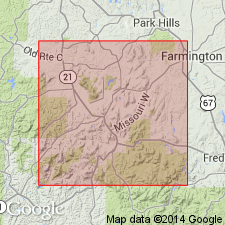
- Usage in publication:
-
- Royal Gorge rhyolite
- Modifications:
-
- First used
- Dominant lithology:
-
- Rhyolite
- AAPG geologic province:
-
- Midcontinent region
Summary:
Royal Gorge rhyolite (new) of Middlebrook group (new). Briefly summarized in reports by W.C. Hayes and J.A. Martin, p. 30, 31, and W.C. Hayes, p. 83 (table 1), this volume. New names are credited to Tolman and Robertson (in prep.) [1969, Missouri Div. Geol. Survey Water Res. Rpt. Inv., no. 44 (Contrib. to Precambrian Geol., no. 1)]. A dull light-brownish-purple porphyritic rhyolite with small red feldspar phenocrysts. Age is Precambrian.
Occurs in St. Francois Mountain area. Sample collected in E/2 SE/4 SW/4 sec. 14, T. 33 N., R. 3 E., Madison Co., southeastern MO. Royal Gorge feature is in T. 33 N.,
R. 3 E., Iron Co., southeastern MO.
Source: Modified from US geologic names lexicon (USGS Bull. 1350, p. 646).
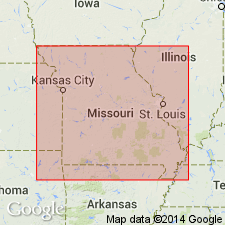
- Usage in publication:
-
- Royal Gorge rhyolite
- Modifications:
-
- Geochronologic dating
- AAPG geologic province:
-
- Midcontinent region
Summary:
Whole rock Rb-Sr age determined to be 1420 +/-30 m.y. Study area in St. Francois Mountains, southeast MO, Midcontinent region. Other units having same Rb-Sr age as Royal Gorge include Hogan Mountain rhyolite, rhyolite of Johnson Shut-ins, and Pilot Knob felsite. Older than Munger granite porphyry and Magee granite (1260 +/-30 my.) and Stout's Creek rhyolite (1315 +/-35 m.y.). Age similar to Silvermine and Butler Hill granites (1400-1450 m.y.).
Source: GNU records (USGS DDS-6; Denver GNULEX).

- Usage in publication:
-
- Royal Gorge rhyolite
- Modifications:
-
- Principal reference
- Dominant lithology:
-
- Rhyolite
- AAPG geologic province:
-
- Midcontinent region
Summary:
Royal Gorge rhyolite of Middlebrook group. Has characteristic reddish-purple tint with small, indistinct, deep salmon-red feldspar phenocrysts in aphanitic groundmass; very small quartz phenocrysts; flow layers commonly indistinct. Full areal extent not known. Exposed from area north of Cuthbertson Mountain to area south of Ketcherside Mountain, and along lower flanks of Hogan Mountain, in St. Francois Mountains, Iron County, southeastern Missouri. Age is Precambrian.
Type locality: the shut-ins on Big Creek known as Royal Gorge, in SE/4 sec. 6, T. 33 N., R. 3 E., Iron Co., MO. Origin of name not stated by authors, but probably named from Royal Gorge.
[GNU remark (Feb. 16, 1990, USGS DDS-6; Denver GNULEX): Stratigraphic relationships of units of Middlebrook not discussed in text; geologic map (plate 1) missing from library copy of report.]
Source: Modified from GNU records (USGS DDS-6; Denver GNULEX).
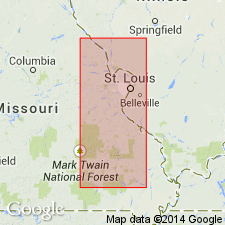
- Usage in publication:
-
- Royal Gorge Rhyolite
- Modifications:
-
- Geochronologic dating
- AAPG geologic province:
-
- Midcontinent region
Summary:
U-Pb age of 1525 +/-40 m.y. determined on zircon; Rb-Sr age of 1331 +/-40 m.y. determined on whole rock/mineral separates. Rb-Sr ages on some rocks are consistently lower than U-Pb ages probably due to removal of Sr from rock. Age of most rocks studied is about 1500 m.y., but a real event as recorded by Rb-Sr occurred about 1300 m.y. ago. Samples are taken from St. Francois Mountains, southeast MO, Midcontinent region.
Source: GNU records (USGS DDS-6; Denver GNULEX).
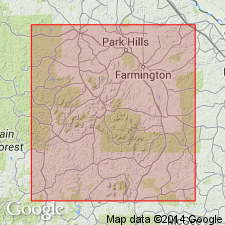
- Usage in publication:
-
- Royal Gorge Rhyolite
- Modifications:
-
- Geochronologic dating
- AAPG geologic province:
-
- Midcontinent region
Summary:
U-Pb age on zircons determined to be 1530 +/-20 m.y. Rb-Sr data on whole rock samples of Unit 810 of Berry (1970, unpub. thesis, Univ. Kansas) yields an age of 1317 +/-54 m.y. Unit 810 is equivalent to Royal Gorge Rhyolite at Royal Gorge "Shut-in," in T33N, R3E, Iron Co, MO, Midcontinent region, where samples were taken. Specific localities listed in appendix 3. Rb-Sr data probably underestimates actual age; low age probably due to Sr loss. Analytical data in appendices 2 and 4.
Source: GNU records (USGS DDS-6; Denver GNULEX).
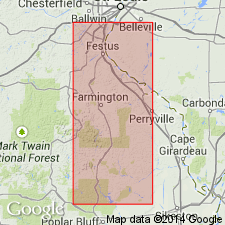
- Usage in publication:
-
- Royal Gorge Rhyolite
- Modifications:
-
- Principal reference
- Revised
- AAPG geologic province:
-
- Midcontinent region
Summary:
Royal Gorge Rhyolite. Unit is part of sequence of Precambrian volcanic rocks associated with Taum Sauk caldera in western part of St. Francois Mountains, southeast Missouri (Midcontinent region). Divided into massive and banded units. Consists of red to maroon lava flow containing 5 percent phenocrysts of quartz and alkali feldspar; vividly banded red and white at many localities. Thickness up to 700 feet. Age is Precambrian. Report includes geologic map. Unit named and described on stratigraphic column (table 1).
Royal Gorge Rhyolite replaces: Hogan Mountain Rhyolite (Crane, Lee, Proffit, and Taum Sauk Mountains, and Royal Gorge), Middlebrook Group (College Hill), Royal Gorge Rhyolite (Royal Gorge), and Stouts Creek Rhyolite (Royal Gorge area, and College Hill) as mapped by Tolman and Robertson (1969, Missouri Geol. Survey Rpt. Inv., no. 44); upper part of undifferentiated felsite of Anderson (1970, Missouri Geol. Survey Rpt. Inv., no. 46); and Unit 810b of Berry and Bickford (1972, Bull. Volcanology, v. 36, p. 303-318).
Type section [composite]: in S/2 sec. 14, T. 33 N., R. 3 E. (massive units), and SE/4 SE/4 sec. 3, T. 33 N., R. 3 E. (banded units), Ironton quadrangle, Iron Co., MO. [Type locality for Royal Gorge previously designated (see Tolman and Robertson, 1969).]
[GNU remark (Feb. 21, 1992, USGS DDS-6; Denver GNULEX): Appears to be a major revision of Tolman and Robertson's (1969) Royal Gorge and a new name should have been used for these rocks. Stratigraphic relationship revised; is considered younger than Bell Mountain Rhyolite (new) and older than Taum Sauk Rhyolite (new). Is presumably removed from Middlebrook Group and Middlebrook is presumably abandoned though this is not stated by the author.]
Source: Modified from GNU records (USGS DDS-6; Denver GNULEX).
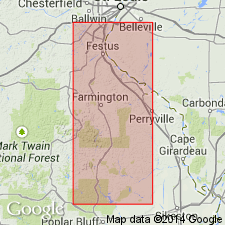
- Usage in publication:
-
- Royal Gorge Rhyolite
- Modifications:
-
- Geochronologic dating
- AAPG geologic province:
-
- Midcontinent region
Summary:
Whole rock Rb-Sr age of 1346 +/-31 m.y and zircon U-Pb age of 1550 +/-20 m.y. on Royal Gorge in St. Francois Mountains, MO, Midcontinent region. U-Pb age is probably more reliable than Rb-Sr age because of less analytical scatter and more consistent results for U-Pb data and probable lowering of Rb-Sr age due to loss of Sr.
Source: GNU records (USGS DDS-6; Denver GNULEX).
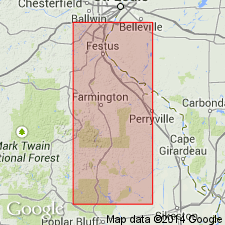
- Usage in publication:
-
- Royal Gorge Rhyolite
- Modifications:
-
- Revised
- AAPG geologic province:
-
- Midcontinent region
Summary:
Royal Gorge Rhyolite, 10th formation from base (of 12) of /Taum Sauk Group (new) of /St. Francois Mountains Volcanic Supergroup (revised). Study area is St. Francois Mountains, southeast Missouri (Midcontinent region). Overlies Bell Mountain Rhyolite (revised) of Taum Sauk Group; underlies /Taum Sauk Rhyolite (revised) of Taum Sauk Group. Age is Precambrian Y. Nomenclature listed in table 1.
[Conflicts with nomenclature guidelines (ACSN, 1970; NACSN, 1983, 2005, 2021): name Taum Sauk used for both group and formation within it (Taum Sauk Rhyolite has priority); name St. Francois Mountains applied concurrently to two different units in same area; a [supergroup] name combines a geographic name with the term ["supergroup,"] and no lithic designation is included.]
Source: Modified from GNU records (USGS DDS-6; Denver GNULEX).

- Usage in publication:
-
- Royal Gorge Rhyolite
- Modifications:
-
- Not used
Summary:
Not used in Ketcherside Mountain area, located within St. Francois Mountains, southeast MO, Midcontinent region. Replaced by informal units referred to as Little Creek and Glover formations. Table 1 shows comparison of nomenclature with previous workers.
Source: GNU records (USGS DDS-6; Denver GNULEX).
For more information, please contact Nancy Stamm, Geologic Names Committee Secretary.
Asterisk (*) indicates published by U.S. Geological Survey authors.
"No current usage" (†) implies that a name has been abandoned or has fallen into disuse. Former usage and, if known, replacement name given in parentheses ( ).
Slash (/) indicates name conflicts with nomenclatural guidelines (CSN, 1933; ACSN, 1961, 1970; NACSN, 1983, 2005, 2021). May be explained within brackets ([ ]).

